A Novel Hybrid Control Strategy and Dynamic Performance Enhancement of a 3.3 kW GaN–HEMT-Based iL2C Resonant Full-Bridge DC–DC Power Converter Methodology for Electric Vehicle Charging Systems
Abstract
:1. Introduction
- Modeling of iL2C converter topology was carried out to enhance the load capacity, reduce the current ripples, and reduce the circulating current;
- A hybrid control strategy was introduced across all operating modes to improve the regulation, minimize switching losses, and enable soft switching;
- Theoretical and simulation analysis was performed for various load conditions of the converter, including full load, half load, and light load with load regulation of the voltage, and current was also described;
- To examine the controller performance, simulations were performed for variable input voltages with line regulation of load voltage, and current deviations were determined;
- An experimental prototype for a 3.3 kW electric vehicle charger was demonstrated using GaN-HEMT technology;
- Furthermore, the highlights of the entire theoretical, simulation, and experimental validations were discussed for steady-state and transient voltage and current ripples at the load side.
2. Interleaved L2C Resonant FB DC–DC Converter Topology and the Working Principle
3. Parameter Design
4. Hybrid Control Strategy
5. Simulation Results and Analysis
5.1. Case 1: Performance Analysis of the Converter for a Nominal Input Voltage (400 Vin) with a Fixed Output Voltage (48 V0) at Full Load Condition, i.e., 3.3 kW
5.2. Case 2: Performance Analysis of the Converter for a Nominal Input Voltage (400 Vin) with a Fixed Output Voltage (48 V0) at a Half Load Condition, i.e., 1.65 kW
5.3. Case 3: Performance Analysis of the Converter for a Nominal Input Voltage (400 Vin) with a Fixed Output Voltage (48 V0) at a Light Load Condition, i.e., 0.33 kW
5.4. Case 4: Performance Analysis of the Converter for a Variable Input Voltage (300–500 Vin) at a Fixed Output Voltage (48 V0) at a Full Load Condition
5.5. Case 5: Performance Analysis of the Converter for a Variable Input Voltage (500–300Vin) at a Fixed Output Voltage (48 V0) at a Full Load Condition
6. Experimental Analysis
7. Converter Analysis Tables
8. Conclusions
Author Contributions
Funding
Data Availability Statement
Conflicts of Interest
Abbreviations
| AC | Alternating Current |
| BEV | Battery Electric Vehicle |
| CV | Constant Voltage |
| DC | Direct Current |
| EMI | Electromagnetic Interference |
| E-mode | Enhancement mode |
| EV | Electric Vehicle |
| FB | Full Bridge |
| FCEV | Fuel cell Electric Vehicle |
| GaN | Gallium nitride |
| HEMT | High Electron Mobility Transistor |
| HEV | Hybrid Electric Vehicle |
| ICE | Internal Combustion Engine |
| iL2C | Interleaved Inductor–inductor–capacitor |
| L2C | Inductor–inductor–capacitor |
| PHEV | Plugin Hybrid Electric Vehicle |
| SCEV | Super Capacitor Electric Vehicle |
| Si | Silicon |
| UCEV | Ultra-Capacitor Electric Vehicle |
| VCO | Voltage Control Oscillator |
| VFPSM | Variable Frequency Phase Shift Modulation |
| ZCS | Zero Current Switching |
| ZVS | Zero Voltage Switching |
References
- Mopidevi, S.; Narasipuram, R.P.; Aemalla, S.R.; Rajan, H. Emobility: Impacts and analysis of future transportation electrification market in economic, renewable energy and infrastructure perspective. Int. J. Powertrains 2022, 11, 264–284. [Google Scholar] [CrossRef]
- Zhou, K.; Wu, Y.; Wu, X.; Sun, Y.; Teng, D.; Liu, Y. Research and development review of power converter topologies and control technology for electric vehicle fast-charging systems. Electronics 2023, 12, 1581. [Google Scholar] [CrossRef]
- Shahjalal, M.; Shams, T.; Tasnim, M.N.; Ahmed, M.R.; Ahsan, M.; Haider, J. A critical review on charging technologies of electric vehicles. Energies 2022, 15, 8239. [Google Scholar] [CrossRef]
- Narasipuram, R.P.; Mopidevi, S. A technological overview & design considerations for developing electric vehicle charging stations. J. Energy Storage 2021, 43, 103225. [Google Scholar]
- Chakraborty, S.; Vu, H.-N.; Hasan, M.M.; Tran, D.-D.; Baghdadi, M.E.; Hegazy, O. DC-DC converter topologies for electric vehicles, plug-in hybrid electric vehicles and fast charging stations: State of the art and future trends. Energies 2019, 12, 1569. [Google Scholar] [CrossRef] [Green Version]
- Raghavendra, K.V.G.; Zeb, K.; Muthusamy, A.; Krishna, T.N.V.; Kumar, S.V.S.V.P.; Kim, D.-H.; Kim, M.-S.; Cho, H.-G.; Kim, H.-J. A comprehensive review of dc–dc converter topologies and modulation strategies with recent advances in solar photovoltaic systems. Electronics 2020, 9, 31. [Google Scholar] [CrossRef] [Green Version]
- Sayed, K.; El-Zohri, E.H.; Mahfouz, H. Analysis and design for interleaved ZCS buck DC-DC converter with low switching losses. Int. J. Power Electron. 2017, 8, 210–231. [Google Scholar] [CrossRef]
- Saleeb, H.; Sayed, K.; Kassem, A.; Mostafa, R. Control and analysis of bidirectional interleaved hybrid converter with coupled inductors for electric vehicle applications. Electr. Eng. 2020, 102, 195–222. [Google Scholar] [CrossRef]
- Lazar, J.F.; Martinelli, R. Steady-state analysis of the LLC series resonant converter. In Proceedings of the Sixteenth Annual IEEE Applied Power Electronics Conference and Exposition, Anaheim, CA, USA, 4–8 March 2001; Volume 2, pp. 728–735. [Google Scholar]
- Bai, H.; Zhang, Y.; Semanson, C.; Luo, C.; Mi, C.C. Modelling design and optimisation of a battery charger for plug-in hybrid electric vehicles. IET Elect. Syst. Transp. 2011, 1, 3–10. [Google Scholar] [CrossRef] [Green Version]
- Deng, J.; Li, S.; Hu, S.; Mi, C.C.; Ma, R. Design methodology of LLC resonant converters for electric vehicle battery chargers. IEEE Trans. Veh. Technol. 2014, 63, 1581–1592. [Google Scholar] [CrossRef]
- Beiranvand, R.; Rashidian, B.; Zolghadri, M.R.; Alavi, S.M.H. A design procedure for optimizing the LLC resonant converter as a wide output range voltage source. IEEE Trans. Power Electron. 2012, 27, 3749–3763. [Google Scholar] [CrossRef]
- Musavi, F.; Craciun, M.; Gautam, D.S.; Eberle, W.; Dunford, W.G. An LLC resonant DC-DC converter for wide output voltage range battery charging applications. IEEE Trans. Power Electron. 2013, 28, 5437–5445. [Google Scholar] [CrossRef]
- Narasipuram, R.P. Analysis, identification, and design of robust control techniques for ultra-lift Luo DC-DC converter powered by fuel cell. Int. J. Comput. Aided Eng. Technol. 2021, 14, 102–129. [Google Scholar] [CrossRef]
- Shi, B.; Yang, F.; Hu, C.; Ouyang, M. Modelling and improvement of oscillation problem in a double-sided LCC compensation network for electric vehicle wireless power transfer. eTransportation 2021, 8, 100108. [Google Scholar] [CrossRef]
- Sun, W.; Xing, Y.; Wu, H. Modified high-efficiency LLC converters with two split resonant branches for wide input-voltage range applications. IEEE Trans. Power Electron. 2017, 33, 7867–7879. [Google Scholar] [CrossRef]
- Kim, B.-C.; Park, K.-B.; Kim, C.-E.; Moon, G.-W. Load sharing characteristic of two-phase interleaved LLC resonant converter with parallel and series input structure. In Proceedings of the Energy Conversion Congress and Exposition (ECCE), San Jose, CA, USA, 20–24 September 2009; pp. 750–753. [Google Scholar]
- Gu, W.-J.; Harada, K. A new method to regulate resonant converters. IEEE Trans. Power Electron. 1988, 3, 430–439. [Google Scholar]
- Ahmad, A.; Khalid, M.; Ullah, Z.; Ahmad, N.; Aljaidi, M.; Malik, F.A.; Manzoor, U. Electric vehicle charging modes, technologies, and applications of smart charging. Energies 2022, 15, 9471. [Google Scholar] [CrossRef]
- Leijon, J.; Boström, C. Charging Electric vehicles today and in the future. World Electr. Veh. J. 2022, 13, 139. [Google Scholar] [CrossRef]
- Guo, B.; Zhang, Y.; Zhang, J.; Gao, J. Hybrid control strategy of phase-shifted full-bridge LLC converter based on digital direct phase-shift control. J. Power Electron. 2018, 18, 802–816. [Google Scholar]
- Yoo, K.-M.; Lee, J.-Y. A 10-kW two-stage isolated/bidirectional dc/dc converter with hybrid-switching technique. IEEE Trans. Ind. Electron. 2013, 60, 2205–2213. [Google Scholar] [CrossRef]
- Park, H.-P.; Jung, J.-H. Power stage and feedback loop design for LLC resonant converter in high switching frequency operation. IEEE Trans. Power Electron. 2017, 32, 7770–7782. [Google Scholar] [CrossRef]
- Narasipuram, R.P. Modelling and simulation of automatic controlled solar input single switch high step-up DC-DC converter with less duty ratio. Int. J. Ind. Electron. Drives 2017, 3, 210–218. [Google Scholar]
- Zhao, L.; Li, H.; Wu, X.; Zhang, J. An improved phase-shifted full-bridge converter with wide-range ZVS and reduced filter requirement. IEEE Trans. Ind. Electron 2018, 65, 2167–2176. [Google Scholar] [CrossRef]
- Long, X.; Chen, D. Small signal modeling of LLC converter with LED load and quasi-resonant controller based active ripple rejection. Energies 2023, 16, 3773. [Google Scholar] [CrossRef]
- Liu, Z.; Li, B.; Lee, F.C.; Li, Q. High-efficiency high-density critical mode rectifier/inverter for wbg-device-based on-board charger. IEEE Trans. Ind. Electron. 2017, 64, 9114–9123. [Google Scholar] [CrossRef]
- Keshmiri, N.; Wang, D.; Agrawal, B.; Hou, R.; Emadi, A. Current status and future trends of GaN HEMTs in electrified transportation. IEEE Access 2020, 8, 70553–70571. [Google Scholar] [CrossRef]
- Musumeci, S.; Barba, V. Gallium Nitride Power Devices in Power Electronics Applications: State of Art and Perspectives. Energies 2023, 16, 3894. [Google Scholar] [CrossRef]
- Sarnago, H.; Lucía, Ó.; Popa, I.O.; Burdío, J.M. Constant-Current Gate Driver for GaN HEMTs Applied to Resonant Power Conversion. Energies 2021, 14, 2377. [Google Scholar] [CrossRef]
- Ma, C.-T. System planning of grid-connected electric vehicle charging stations and key technologies: A review. Energies 2019, 12, 4201. [Google Scholar] [CrossRef] [Green Version]
- Nguyen, D.-D.; Bui, N.-T.; Yukita, K. Design and optimization of three-phase dual-active-bridge converters for electric vehicle charging stations. Energies 2020, 13, 150. [Google Scholar] [CrossRef] [Green Version]
- Musavi, F.; Cracium, M.; Gautam, D.S.; Eberle, W. Control strategies for wide output voltage range LLC resonant DC-DC converters in battery chargers. IEEE Trans. Veh. Technol. 2014, 63, 1117–1125. [Google Scholar] [CrossRef]
- Beiranvand, R.; Rashidian, B.; Zolghadri, M.R.; Alavi, S.M.H. Optimizing the normalized dead-time and maximum switching frequency of a wide-adjustable-range LLC resonant converter. IEEE Trans. Power Electron. 2011, 26, 462–472. [Google Scholar] [CrossRef]
- Shahzad, M.I.; Iqbal, S.; Taib, S. Interleaved LLC converter with cascaded voltage-doubler rectifiers for deeply depleted pev battery charging. IEEE Trans. Transp. Electrif. 2018, 4, 89–98. [Google Scholar] [CrossRef]
- Vu, H.-N.; Choi, W. A novel dual full-bridge LLC resonant converter for CC and CV charges of batteries for electric vehicles. IEEE Trans. Ind. Electron. 2018, 65, 2212–2225. [Google Scholar] [CrossRef]
- Bing, L.; Wenduo, L.; Yan, L.; Lee, F.C.; van Wyk, J.D. Optimal design methodology for LLC resonant converter. In Proceedings of the Twenty-First Annual IEEE Applied Power Electronics Conference and Exposition, Dallas, TX, USA, 19–23 March 2006; pp. 533–538. [Google Scholar]
- Ma, C.-T.; Yao, B.-H. Design and Implementation of an Integrated Control Scheme for GaN-Based Multiple Power Converters. Micromachines 2023, 14, 833. [Google Scholar] [CrossRef] [PubMed]
- Lumbreras, D.; Vilella, M.; Zaragoza, J.; Berbel, N.; Jordà, J.; Collado, A. Effect of the Heat Dissipation System on Hard-Switching GaN-Based Power Converters for Energy Conversion. Energies 2021, 14, 6287. [Google Scholar] [CrossRef]
- Zulauf, G.; Park, S.; Liang, W.; Surakitbovorn, K.N.; Rivas-Davila, J. COSS Losses in 600 V GaN power semiconductors in soft-switched, high- and very-high-frequency power converters. IEEE Trans. Power Electron. 2018, 33, 10748–10763. [Google Scholar] [CrossRef]


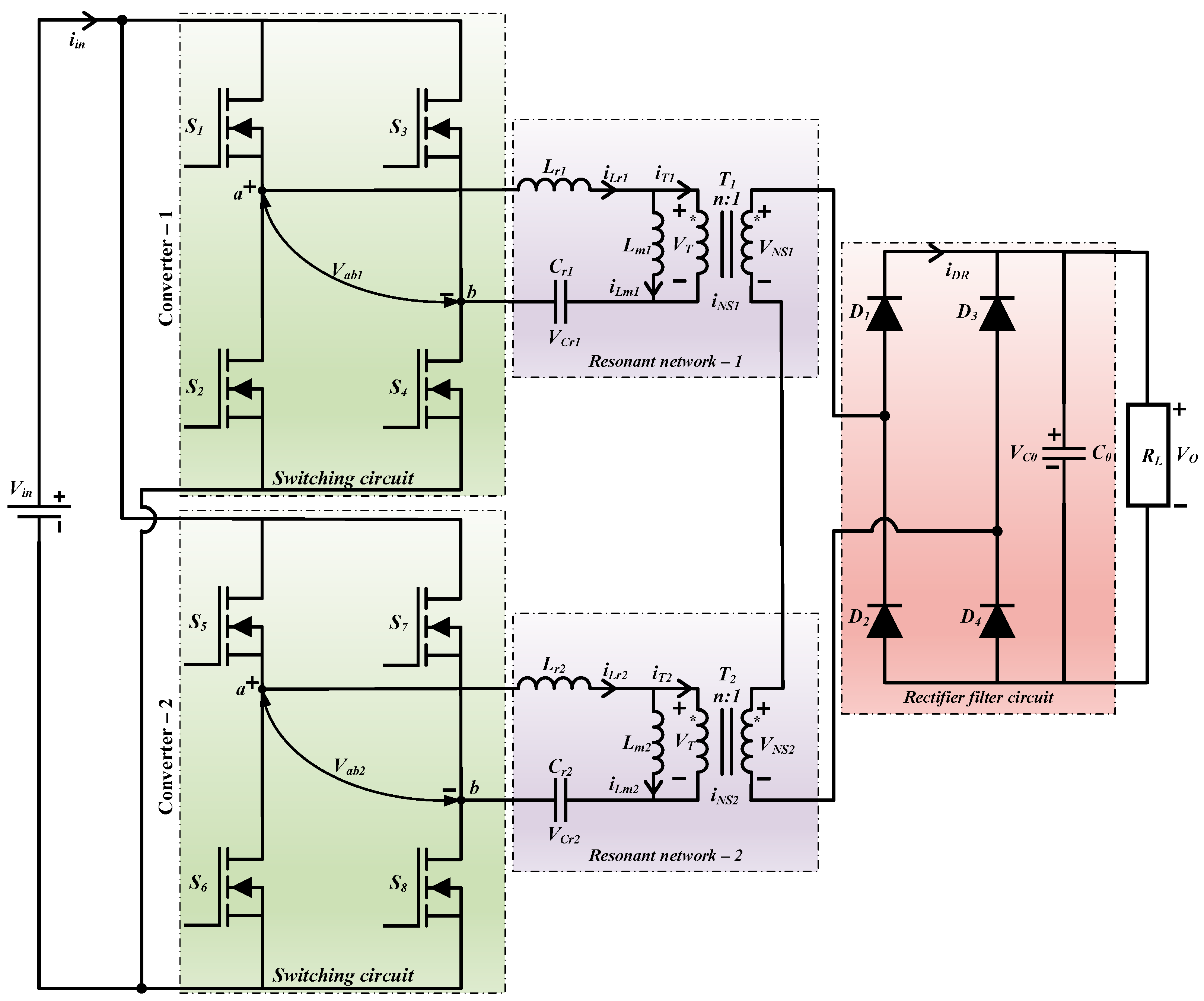
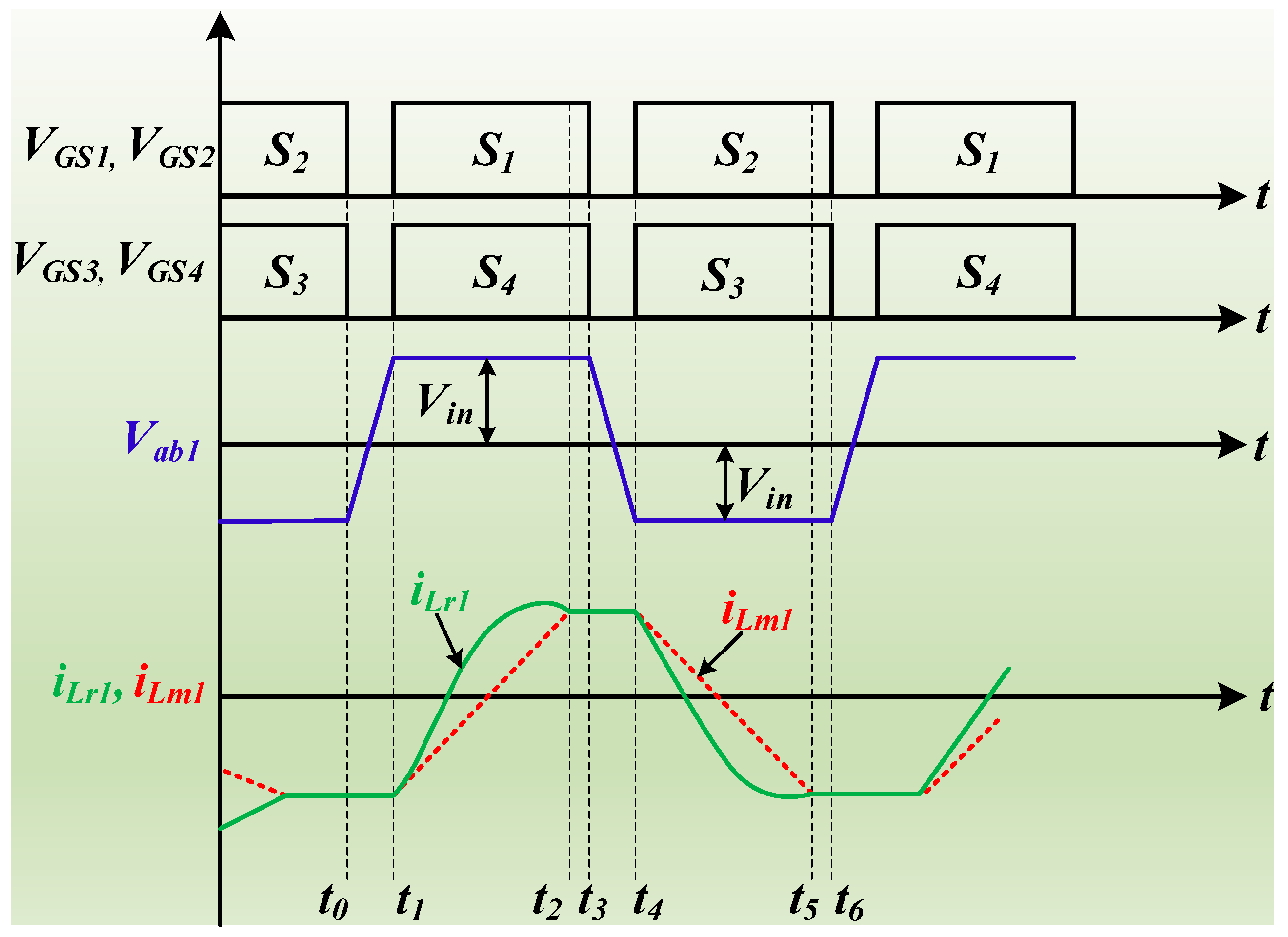


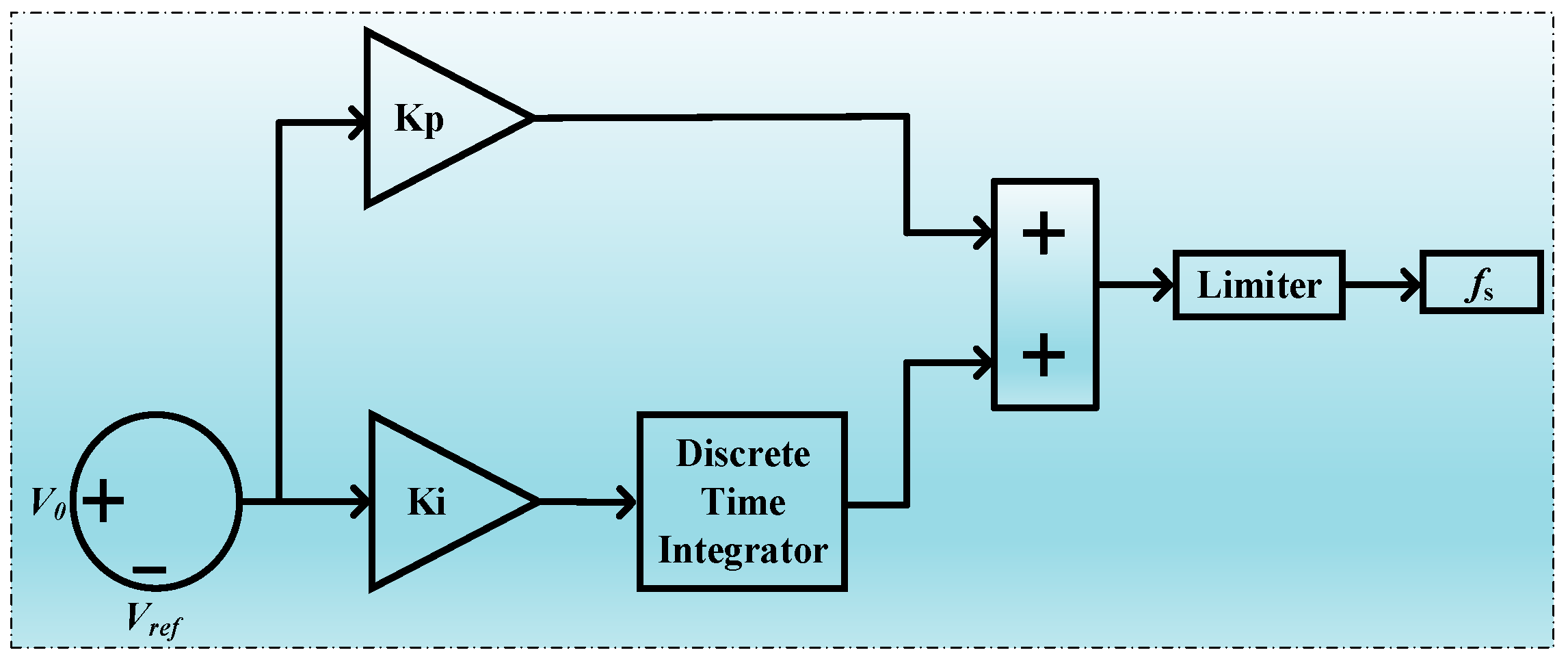
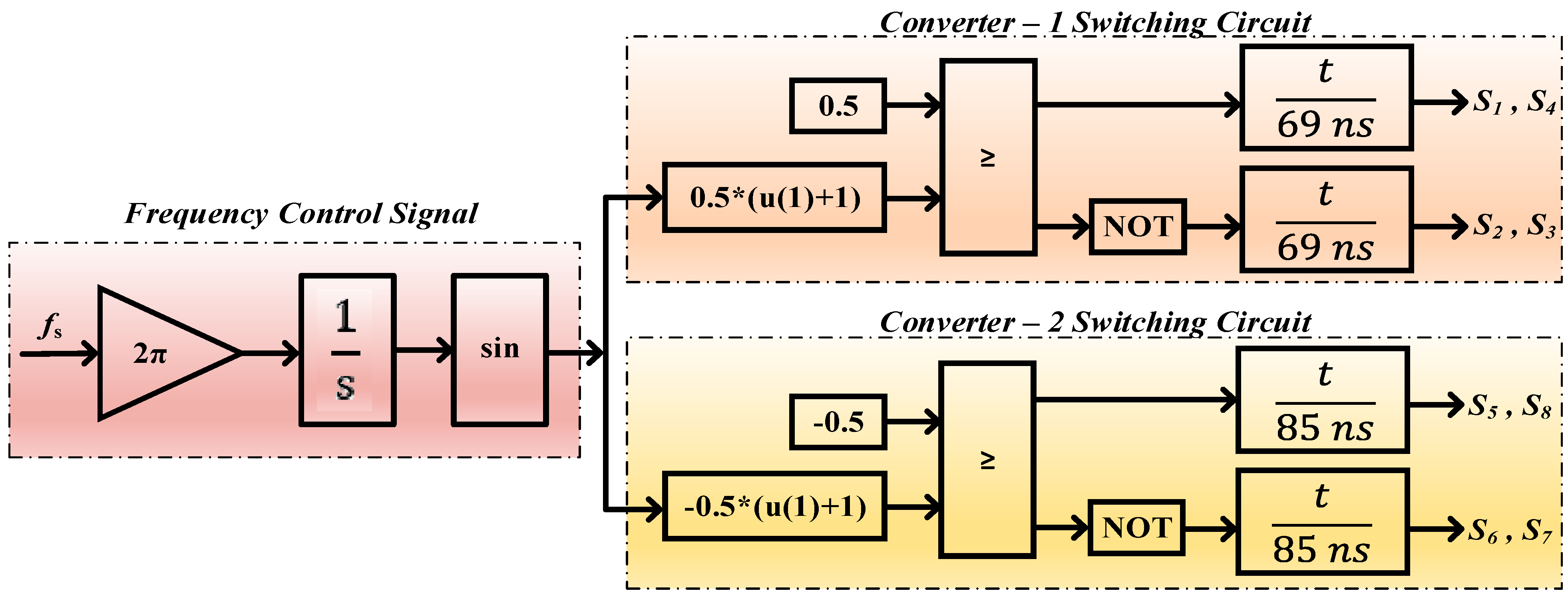

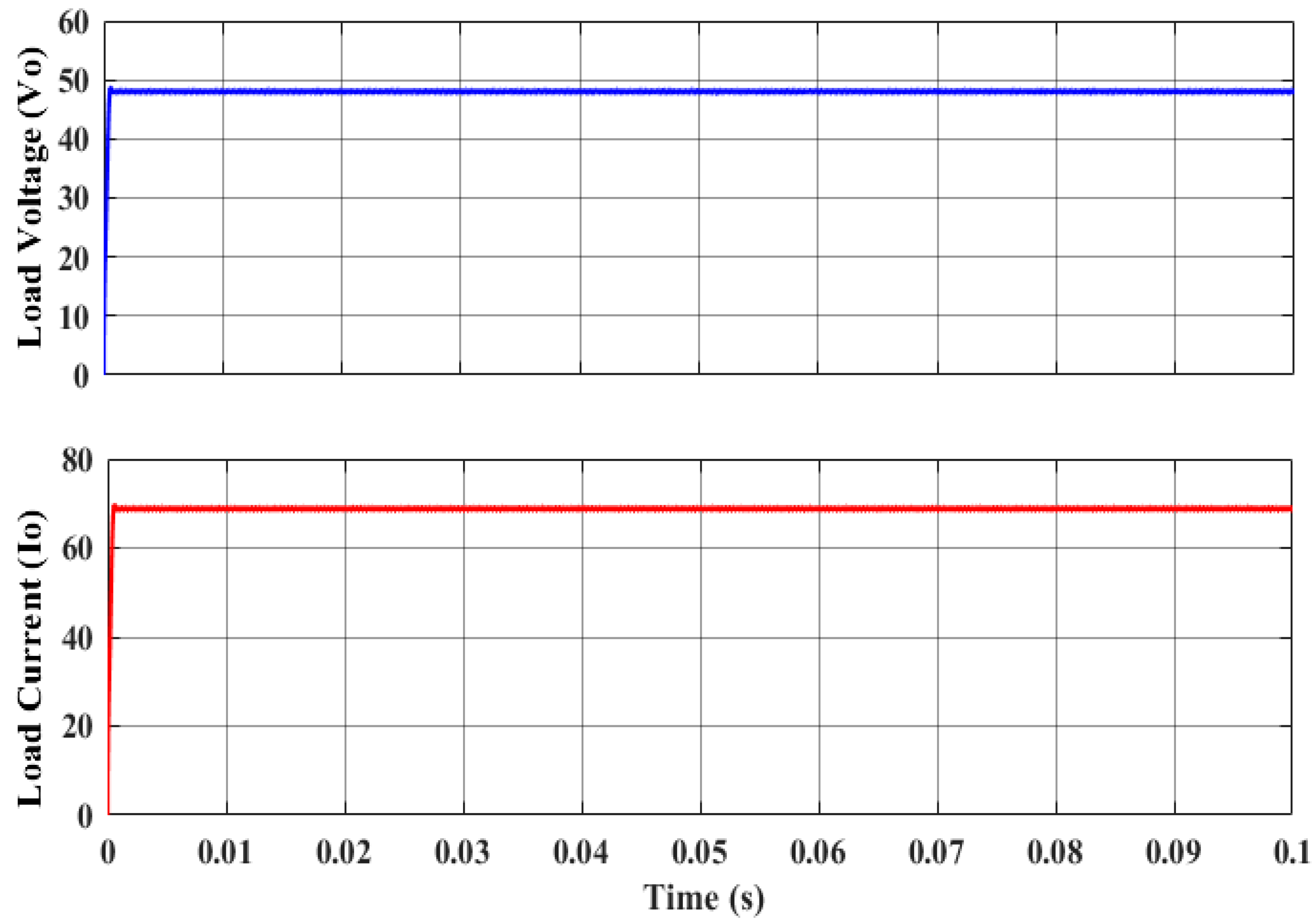
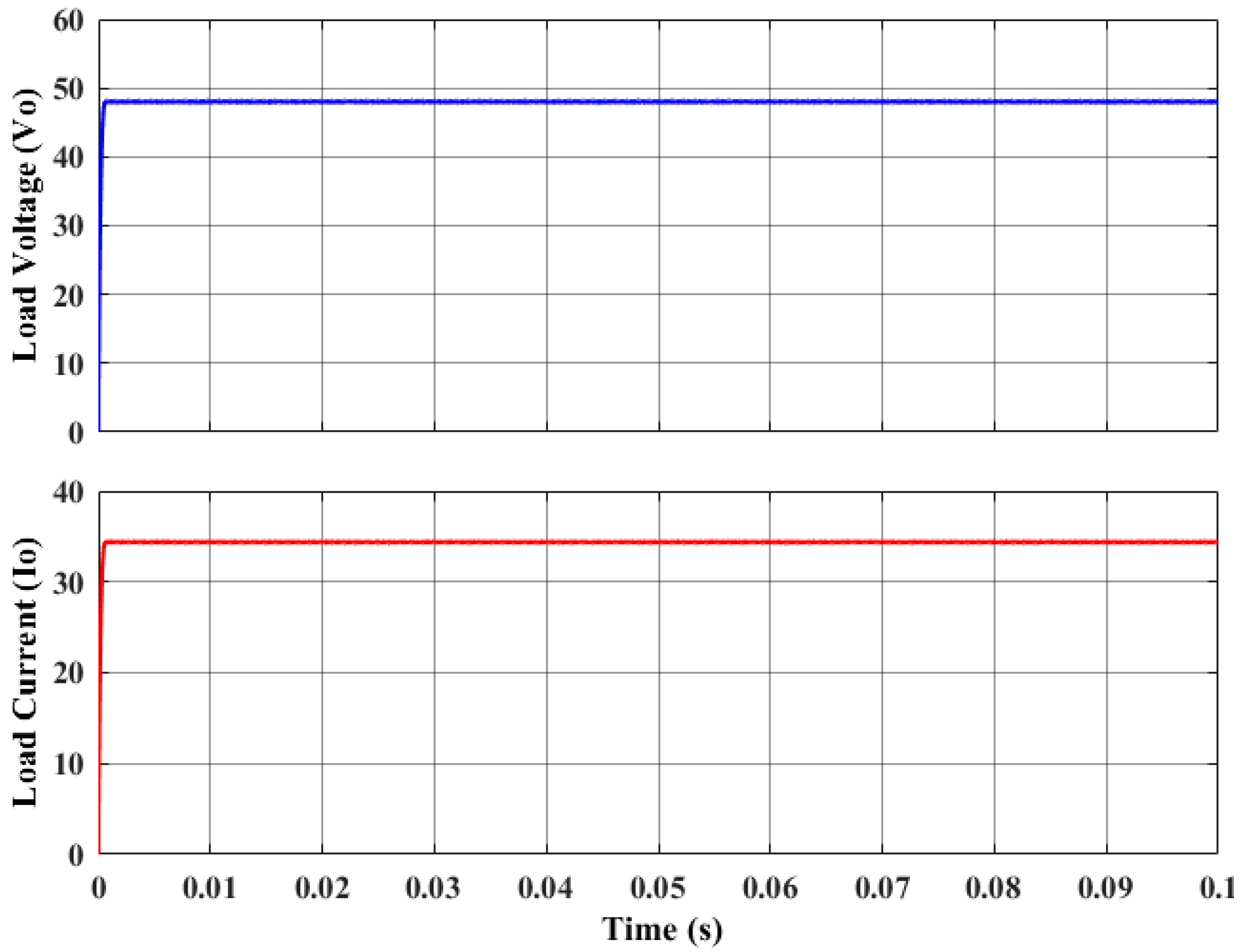
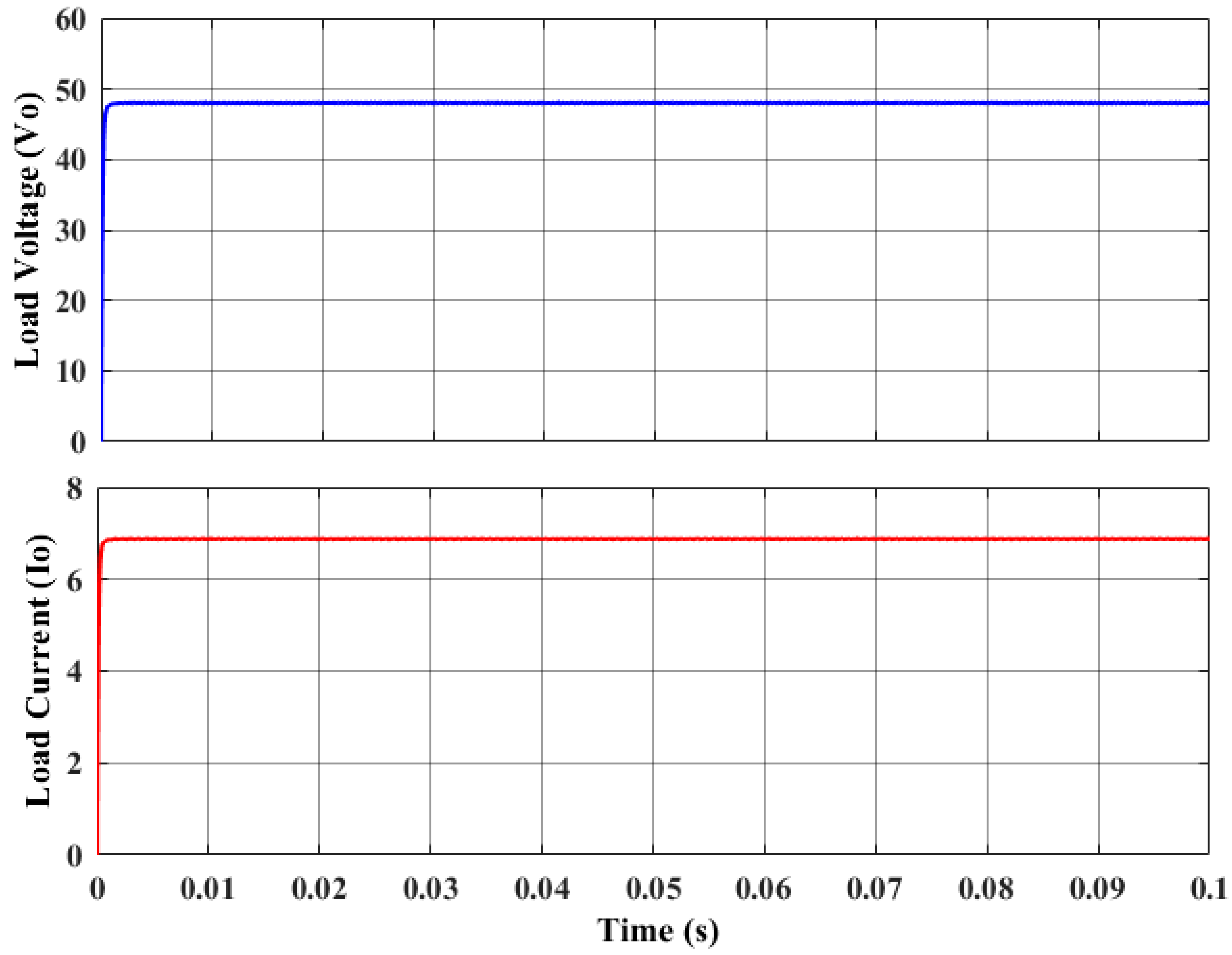


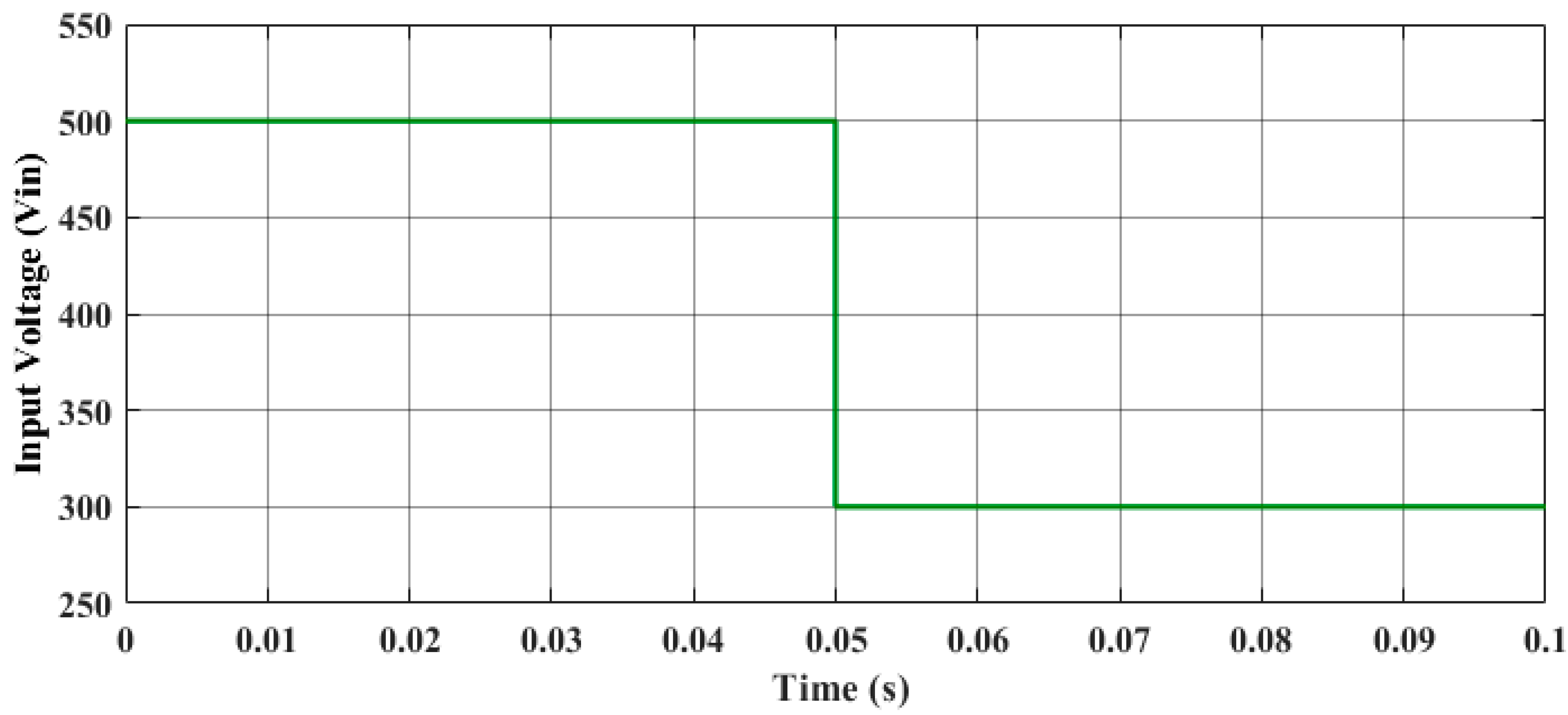
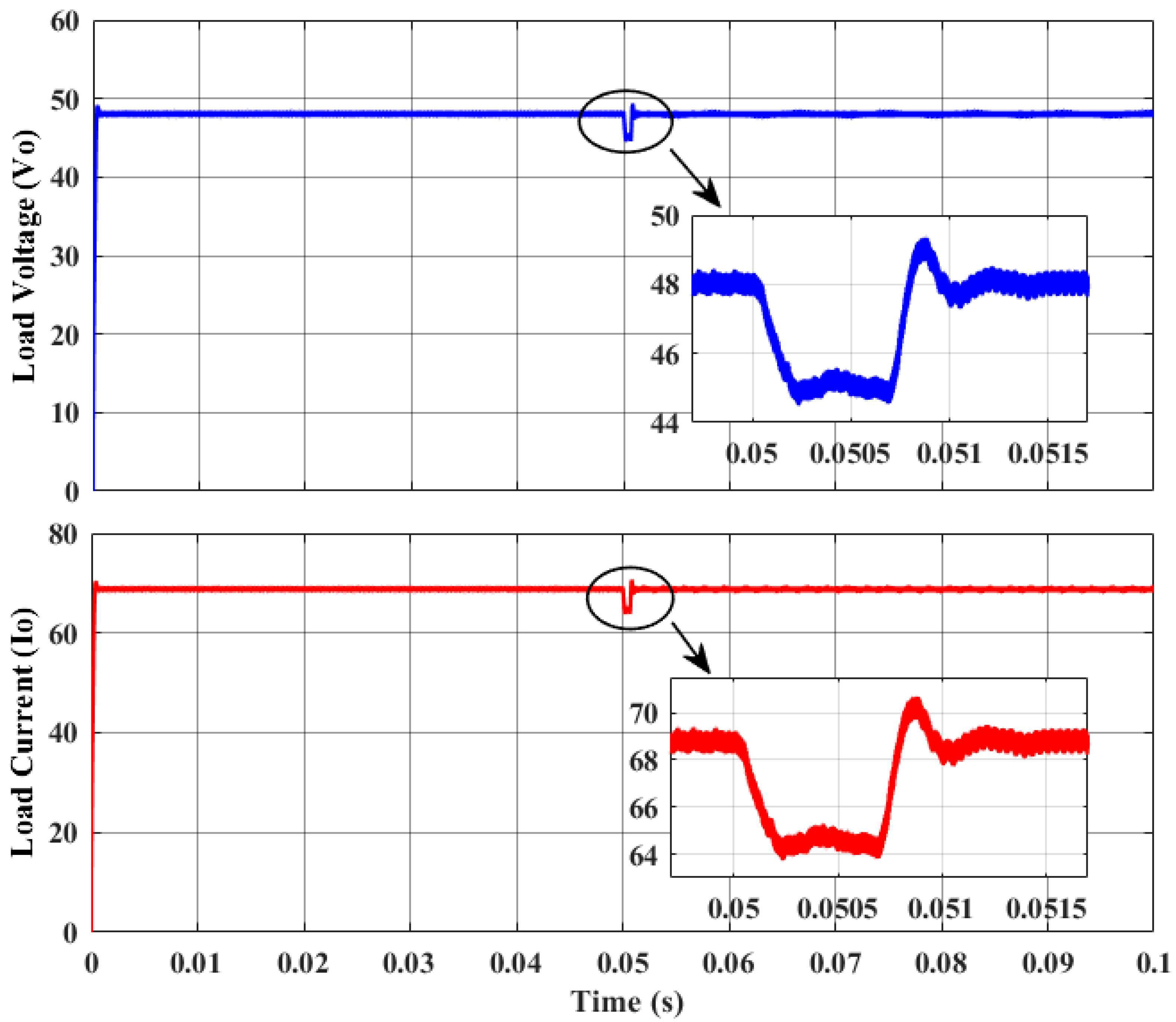
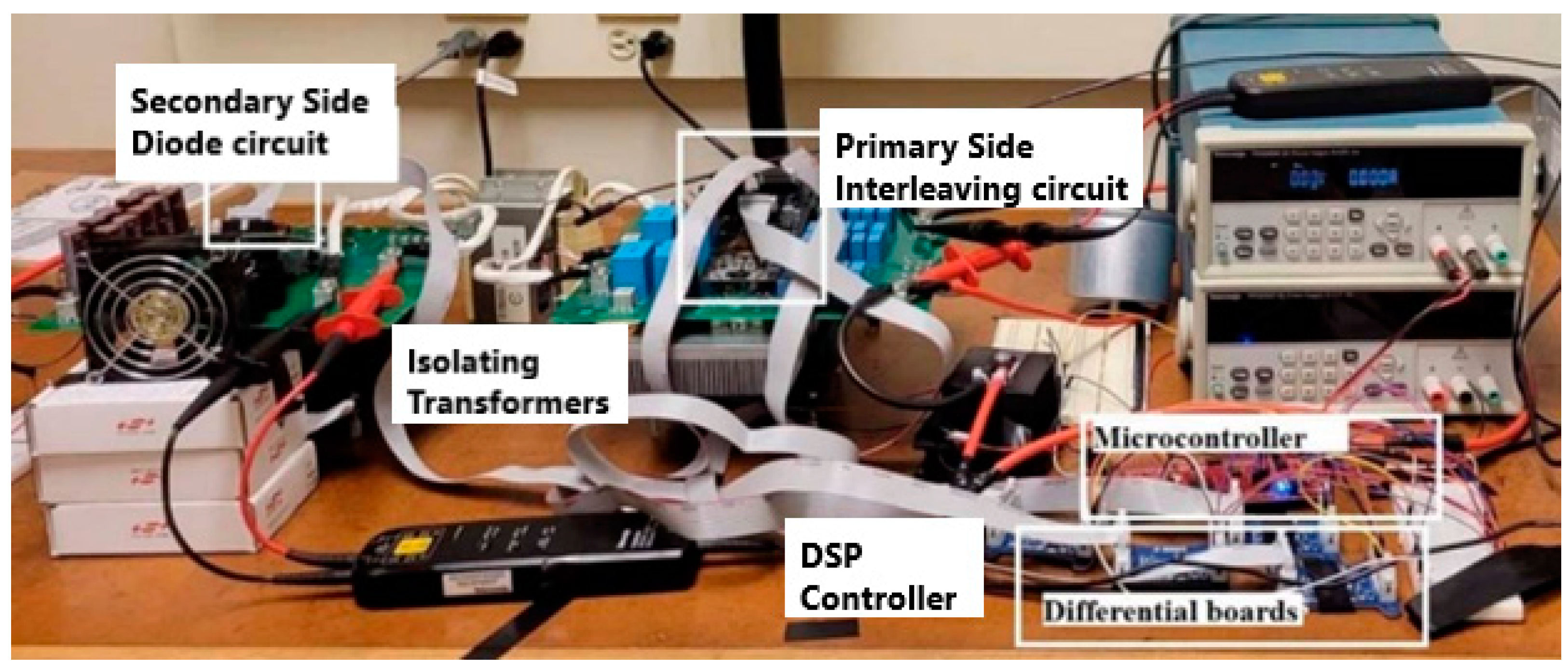
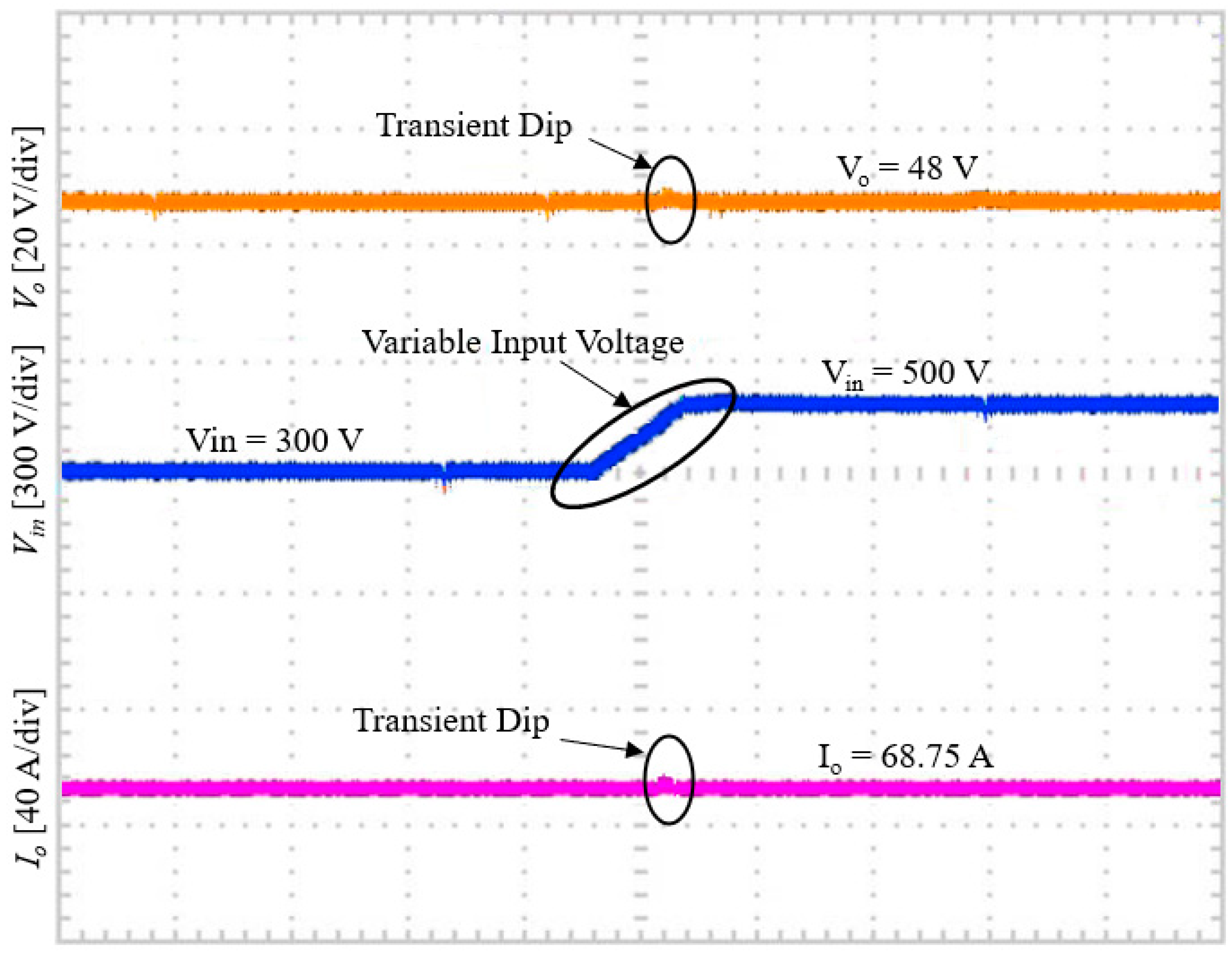
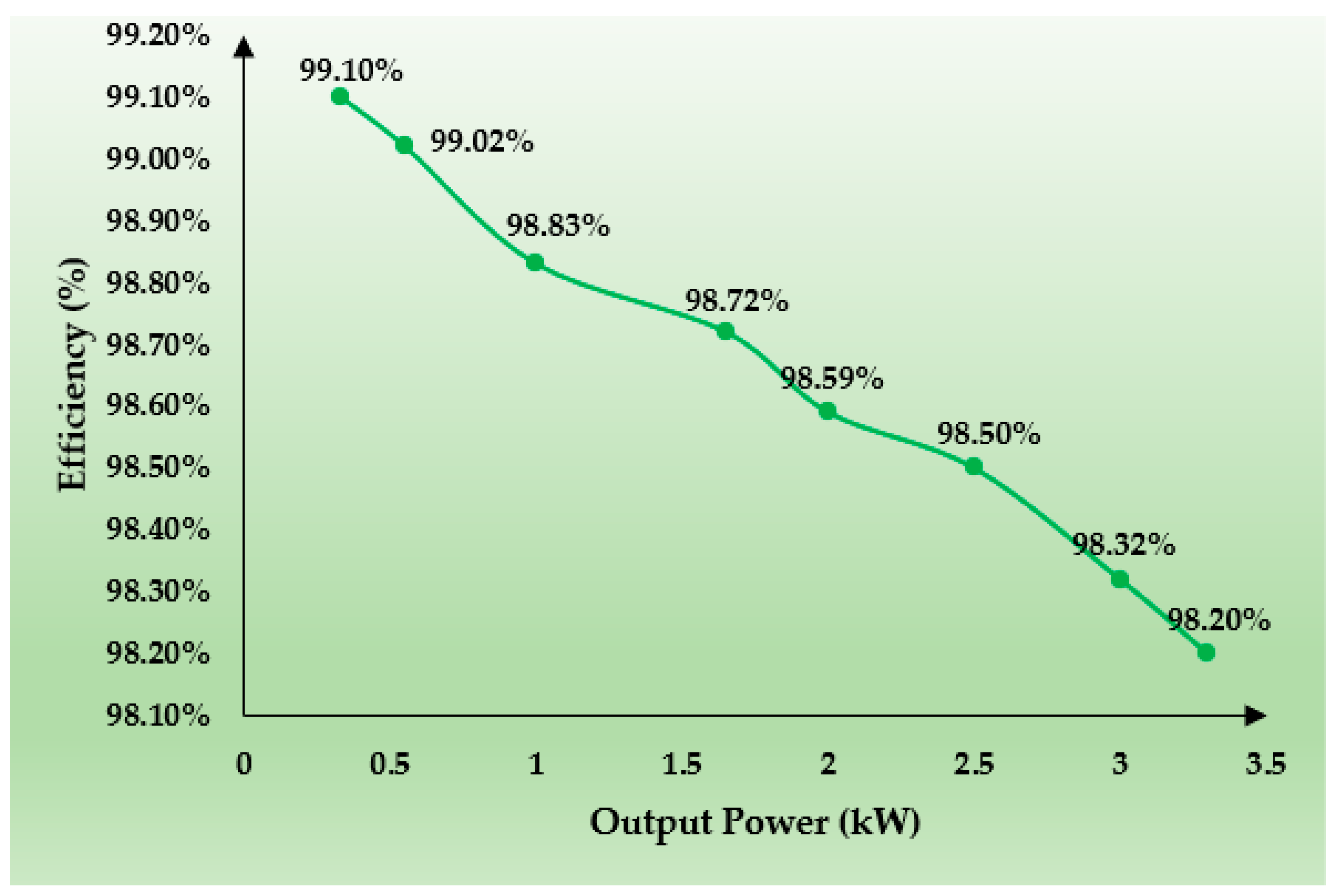
| Parameter Description | Symbol | Electrical Value | Units |
|---|---|---|---|
| Minimum Input Voltage | Vin_min | 300 | Vdc |
| Maximum Input Voltage | Vin _max | 500 | Vdc |
| Rated Output Voltage | Vo | 48 | V |
| Rated Power | P | 3300 | W |
| Maximum Switching Frequency | fn_max | 1.8 × 150 = 270 | kHz |
| Maximum Switching Frequency | fn_min | 120 | kHz |
| Resonant Frequency | fr | 150 | kHz |
| Parameter Description | Symbol | Electrical Value | Units |
|---|---|---|---|
| Maximum Characteristic Impedance | Zo_max | 56.88 | Ω |
| Characteristic Impedance | Zo | 20.83 | Ω |
| Critical Voltage Gain | M_critical | 1.311 | V |
| Magnetizing Inductance | Lm1 | 20.55 | µH |
| Minimum Equivalent Resistance | Rac1_min | 22.12 | Ω |
| Maximum Equivalent Resistance | Rac1_max | 55.81 | Ω |
| Resonant Inductor | Lr1 | 22.11 | µH |
| Resonant Capacitor | Cr1 | 50.94 | nF |
| Transformer Turns | n1 | 8.82 | - |
| Filter Capacitor | C0 | 100 | µF |
| Parameter Description | Symbol | Electrical Value | Units |
|---|---|---|---|
| Drain Source Voltage | Vds | 650 | V |
| Continuous Drain Current | IDs(ON) | 30 | A |
| Drain Source Resistance | RDs(ON) | 50 | mΩ |
| Reverse Recovery Charge | QRR | 0 | nC |
| Total Gate Charge | QG | 5.8 | nC |
| Gate Drain Charge | QGD | 1.8 | nC |
| Gate Source Charge | QGS | 2.2 | nC |
| Turn ON Delay Time @125 °C | td(ON) | 4.3 | ns |
| Turn OFF Delay Time @125 °C | td(OFF) | 8.2 | ns |
| Internal Gate Resistance | RG | 1.1 | Ω |
| Parameter Description | Symbol | Electrical Value | Units |
|---|---|---|---|
| Variable Input Voltage | Vin | 300–500 | V |
| Rated Output Voltage | Vo | 48 | V |
| Rated Power | P | 3300 | W |
| Magnetizing Inductance | Lm1 and Lm2 | 23 | µH |
| Resonant Inductors | Lr1 and Lr1 | 21 | µH |
| Resonant Capacitors | Cr1 and Cr1 | 56 | nF |
| Transformer Turning Ratio | n1 and n2 | 8.82 | - |
| Filter Capacitor | Co | 100 | µF |
| No of Loads | Power (kW) | Efficiency (%) |
|---|---|---|
| 1 (light load) | 0.33 | 99.10 |
| 2 | 0.55 | 99.02 |
| 3 | 1.00 | 98.83 |
| 4 (half load) | 1.65 | 98.72 |
| 5 | 2.00 | 98.59 |
| 6 | 2.50 | 98.50 |
| 7 | 3.00 | 98.32 |
| 8 (full load) | 3.30 | 98.20 |
| Various Load Cases | Load Voltage | Voltage Ripple | Max. Load Voltage Deviation | Avg. %Load Voltage Ripple | |
|---|---|---|---|---|---|
| Minimum | Maximum | ||||
| Case 1: 3.30 kW | 48 V | 47.70 V | 48.50 V | +0.50 V | +1.04% |
| Case 2: 1.65 kW | 48 V | 47.80 V | 48.30 V | +0.30 V | +0.62% |
| Case 3: 0.33 kW | 48 V | 47.94 V | 48.15 V | +0.15 V | +0.31% |
| Various Load Cases | Load Current | Current Ripple | Max. Load Current Deviation | Avg. %Load Current Ripple | |
|---|---|---|---|---|---|
| Minimum | Maximum | ||||
| Case 1: 3.30 kW | 68.75 A | 68.30 A | 69.40 A | +0.650 A | +0.94% |
| Case 2: 1.65 kW | 34.375 A | 34.20 A | 34.55 A | +0.175 A | +0.50% |
| Case 3: 0.33 kW | 6.875 A | 6.865 A | 6.892 A | +0.017 A | +0.25% |
| Variable Input Voltage | Steady State Voltage Ripple | Max. Load VoltageDeviation | Avg. %Load Voltage Ripple | Transient Analysis | |||
|---|---|---|---|---|---|---|---|
| Min | Max | Voltage Dip | Avg% of Dip | Settling Time | |||
| Case 4: 300–500 V | 47.60 V | 48.40 V | +0.40 V | +0.830% | +5.2 V | +10.83% | 1.1 ms |
| Case 5: 500–300 V | 47.70 V | 48.42 V | +0.42 V | +0.875% | −3.5 V | −07.29% | 1.2 ms |
| Variable Input Voltage | Steady State Current Ripple | Max. Load Current Deviation | Avg. %Load Current Ripple | Transient Analysis | |||
|---|---|---|---|---|---|---|---|
| Min | Max | Current Dip | Avg% of Dip | Settling Time | |||
| Case 4: 300–500 V | 68.2 A | 69.34 A | +0.59 A | +0.85% | +7.25 A | +10.54% | 1.1 ms |
| Case 5: 500–300 V | 68.3 A | 69.39 A | +0.64 A | +0.93% | −4.75 A | +06.90% | 1.2 ms |
| Conditions | Steady State Voltage Ripple | Max. Load Voltage Deviation | Avg. %Load Voltage Ripple | Transient Analysis | |||
|---|---|---|---|---|---|---|---|
| Min | Max | Voltage Dip | Avg% of Dip | Settling Time | |||
| Simulations | 47.60 V | 48.40 V | +0.40 V | +0.83% | +5.20 V | +10.83% | 1.1 ms |
| Experimental | 46.50 V | 48.76 V | +0.76 V | +1.58% | +6.17 V | +12.85% | 18 ms |
| Conditions | Steady State Current Ripple | Max. Load Current Deviation | Avg. %Load Current Ripple | Transient Analysis | |||
|---|---|---|---|---|---|---|---|
| Min | Max | Current Dip | Avg% of Dip | Settling Time | |||
| Simulations | 68.2 A | 69.34 A | +0.59 A | +0.85% | +7.25 A | +10.54% | 1.1 ms |
| Experimental | 68.5 A | 70.13 A | +1.38 A | +2.00% | +8.29 A | +12.05% | 18 ms |
Disclaimer/Publisher’s Note: The statements, opinions and data contained in all publications are solely those of the individual author(s) and contributor(s) and not of MDPI and/or the editor(s). MDPI and/or the editor(s) disclaim responsibility for any injury to people or property resulting from any ideas, methods, instructions or products referred to in the content. |
© 2023 by the authors. Licensee MDPI, Basel, Switzerland. This article is an open access article distributed under the terms and conditions of the Creative Commons Attribution (CC BY) license (https://creativecommons.org/licenses/by/4.0/).
Share and Cite
Narasipuram, R.P.; Mopidevi, S. A Novel Hybrid Control Strategy and Dynamic Performance Enhancement of a 3.3 kW GaN–HEMT-Based iL2C Resonant Full-Bridge DC–DC Power Converter Methodology for Electric Vehicle Charging Systems. Energies 2023, 16, 5811. https://doi.org/10.3390/en16155811
Narasipuram RP, Mopidevi S. A Novel Hybrid Control Strategy and Dynamic Performance Enhancement of a 3.3 kW GaN–HEMT-Based iL2C Resonant Full-Bridge DC–DC Power Converter Methodology for Electric Vehicle Charging Systems. Energies. 2023; 16(15):5811. https://doi.org/10.3390/en16155811
Chicago/Turabian StyleNarasipuram, Rajanand Patnaik, and Subbarao Mopidevi. 2023. "A Novel Hybrid Control Strategy and Dynamic Performance Enhancement of a 3.3 kW GaN–HEMT-Based iL2C Resonant Full-Bridge DC–DC Power Converter Methodology for Electric Vehicle Charging Systems" Energies 16, no. 15: 5811. https://doi.org/10.3390/en16155811





